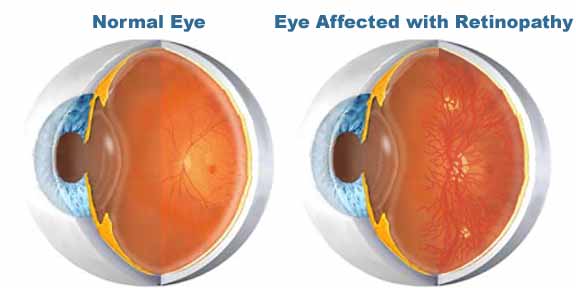Eye Disease
High blood sugars increase the risk of an eye disease called retinopathy.
This disease affects the blood vessels in the retina (the back layer of the eye). One way to explain how the retina works is to think of your eye as a camera and your retina as the film. The retina sends the film or what your eyes are viewing to the brain. The brain develops the film or turns these into images. Click on the image for a larger view.

Retinopathy is a leading cause of blindness.
In the early stages of this eye disease, the blood vessels in the eye become weak. They may leak fluid or blood. They may swell and deposits form on the retina. Over time, some of these tiny blood vessels close and new vessels grow. These new vessels aren't as strong and can burst. They may bleed into the center of the eye. Scar tissue from these new vessels can cause the retina to detach. These later changes lead to poor vision or loss of vision.
You can prevent this eye disease.
A recent study showed that tight blood sugar control reduced the risk of eye disease by 27% and slowed damage to the eye by 34-76%. This is a good reason to keep blood sugars in control.
Here are some steps to prevent eye disease:
- Keep your blood sugars under good control. Aim for blood sugars of 80 mg/dl-120 mg/dl before meals, and 100 mg/dl-140 mg/dl at bedtime.
- Keep your hemoglobin A1c at 7% or less (a 3 month average blood sugar test)
- Don't smoke
- Eat a healthy diet
- Exercise most days
- Work with your health care team to control cholesterol and blood pressure.
- Have a dilated eye exam every year.
Questions?
If you have further questions about retinopathy, contact your diabetes healthcare team.
 Continue Continue 
|





